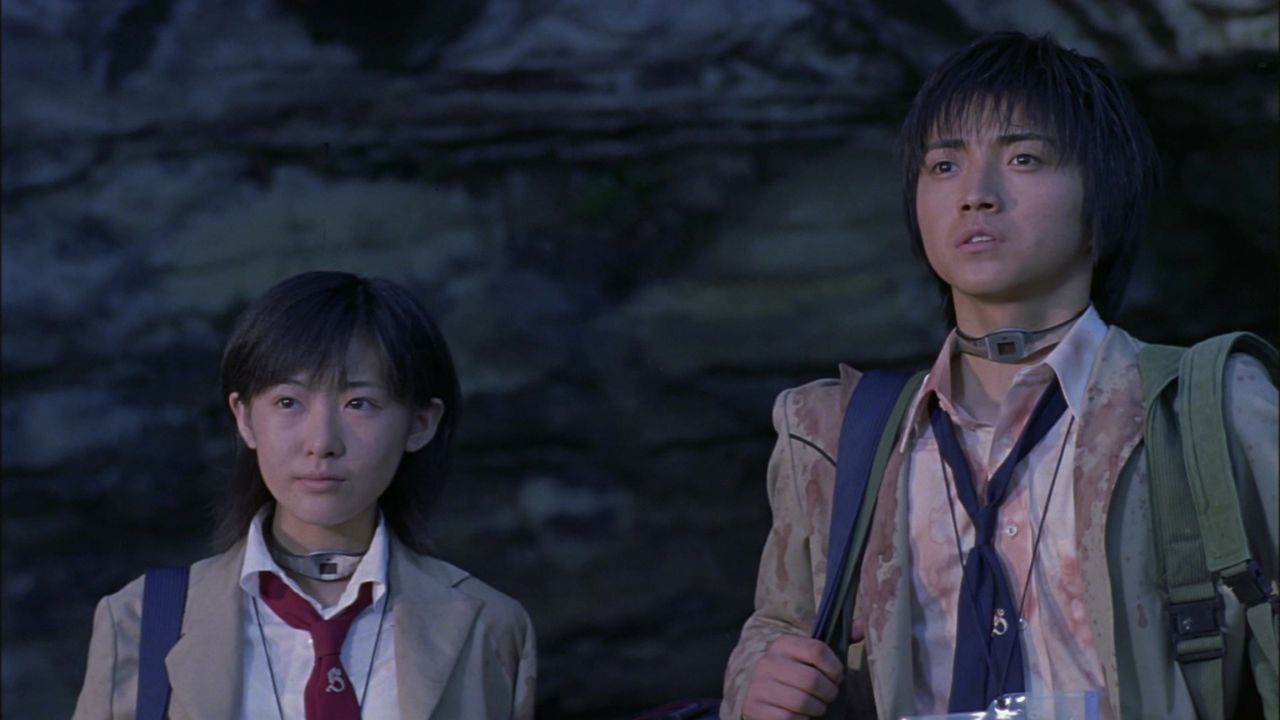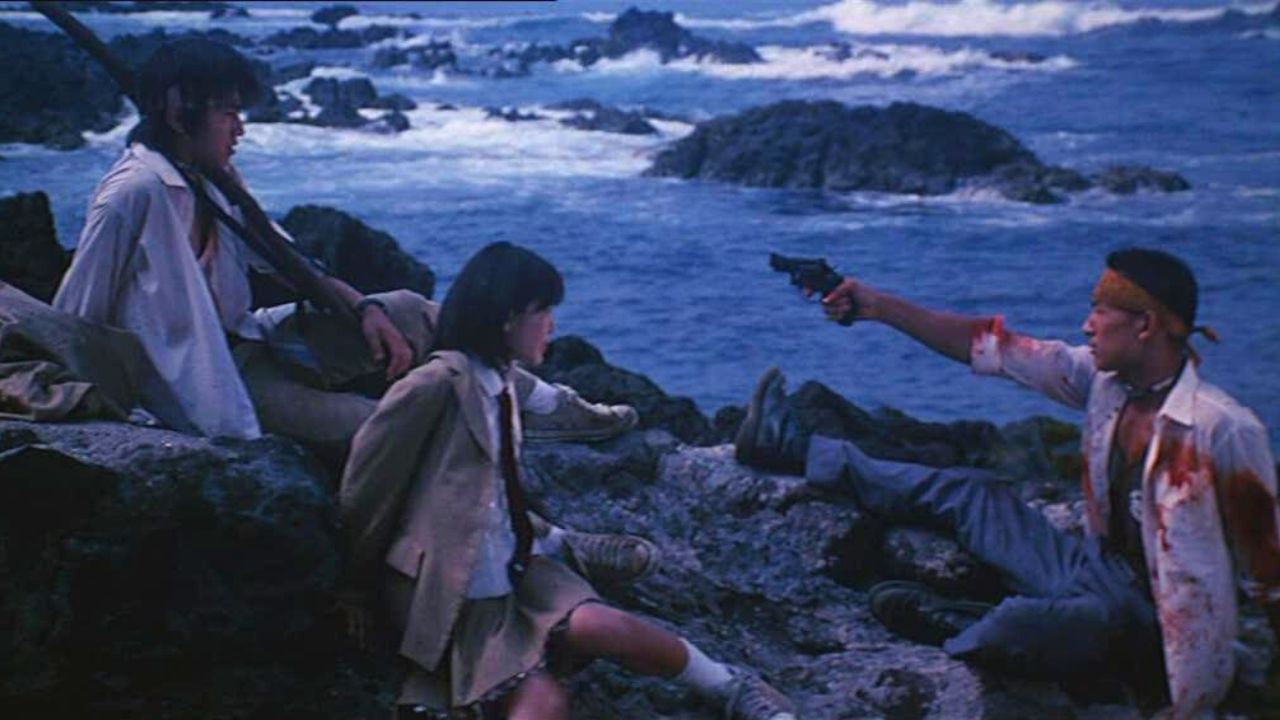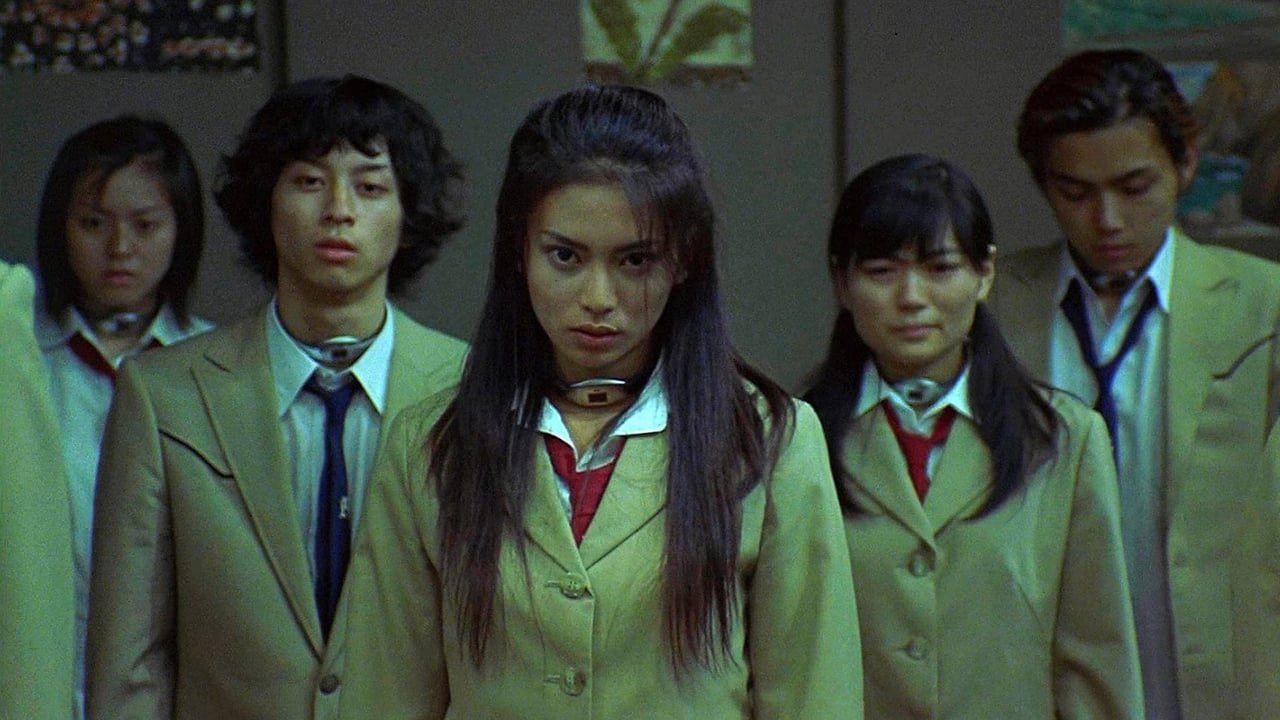This post includes a brief plot summary and an explanation about the ending of the film “Battle Royale” (2000). Beware of spoilers.
Directed by Kinji Fukasaku, the 2000 action drama stars Tatsuya Fujiwara as Shuya Nanahara, Aki Maeda as Noriko Nakagawa, Tarō Yamamoto as Shogo Kawada and Takeshi Kitano as Kitano.
The film “Battle Royale” is set in a dystopian near-future where Japan is grappling with a major recession and a high unemployment rate. To control the rising tide of juvenile delinquency, the government enacts the “BR Act”. This law mandates a deadly game known as Battle Royale.
Usually, a class of delinquent students is chosen to fight to the death on an isolated island. Before the game starts, each student is entitled to a map, some food supplies and a random weapon. To control the “players”, the government uses explosive collars on the students. These can detonate if they disobey the rules. The only way to win “Battle Royale” is to become the sole survivor, who earns the right to return home.

What Happens in “Battle Royale”? (Plot Explained)
There are two main characters in “Battle Royale”, Shuya Nanahara and Noriko Nakagawa, two friends who refuse to kill and try to find a way to escape from the island. Together, they face various dangers and challenges. These range from other fellow students trying to kill them to forbidden zones and even their own teacher, Kitano.
Despite their struggles, Shuya and Noriko also meet other students who ally with them or help them. One of those people is Kawada, a game veteran who knows how to deactivate the collars. Another person would be Sugimura, who is searching for his secret crush.
As the story progresses, each student eventually meets their own fate. Panic, despair and madness set in among the youngsters. Some commit suicide, others rebel against the system, and others still try to maintain their humanity and hope. However, there are also some who show extreme cruelty towards their fellow colleagues.
Meanwhile, Shuya, Noriko and Kawada are still in the game. Nevertheless, they still have to face another major threat: Kiriyama, the most bloodthirsty and relentless student in the game. After Kawada successfully kills Kiriyama, he deactivates Shuya and Noriko’s collars and pretends to kill them.
Kitano ends the game and shuts down the system. Alone, he waits for Kawada, the winner. Shortly after, Kitano realizes that Kawada didn’t arrive alone, Shuya and Noriko are still alive. Together, they confront the teacher.
In the control room, Kitano reveals a homemade painting of the massacred class, showing Noriko as the sole survivor. After that, Kitano pulls out a gun and Shuya shoots him. Meanwhile, the teacher receives a phone call from his daughter. They argue with each other, and Kitano eventually dies from his wounds.
The Ending of “Battle Royale” Explained
The ending of “Battle Royale” shows Shuya, Noriko and Kawada escaping the remote island on a boat. During the journey, Kawada dies from his injuries, but he seemed happy to have found friendship. Meanwhile, the Japanese government declares Shuya and Noriko fugitives. The last sighting of them is in early Tokyo morning, on the run towards Shibuya Station.
What Is the Significance of the Boat Scene?
The boat scene at the end of Battle Royale holds significant meaning. It symbolizes the trio’s escape from the horrific game and their journey into an uncertain future. In addition, it also marks the beginning of Shuya and Noriko’s lives as fugitives, a testament to their resilience and will to survive despite the odds.
Having said that, the boat scene is sort of bittersweet. On the one hand, Kawada’s death puts an end to his tragic story. However, not all was in vain, as he found solace in the friendship he formed with Shuya and Noriko. On the other hand, the remaining students were able to escape the oppressive and totalitarian regime that rules their society. However, rebelling against the system and freedom come with a price.

What Is the Meaning Behind Kitano’s Final Words to Noriko?
Kitano’s final words to Noriko in Battle Royale reveal his deep affection for her. The man saw Noriko as a surrogate daughter, a stark contrast to his own child, who rejected him. His feelings stem from Noriko’s kindness toward him when he was their teacher.
The teacher’s confession also highlights his struggle with the hatred between him and his students. This animosity, amplified by his daughter’s rejection, led him to support the “Battle Royale”. One could interpret Kitano’s request for Noriko to kill him as his desire for an end to his emotional torment.
So what is the meaning behind the final scene? The ending of “Battle Royale” serves as a commentary on corrupt and oppressive systems. It provides a somewhat optimistic message that change and resistance are possible even in extremely totalitarian societies. Shuya and Noriko dared to rebel against the government. They did it without losing their humanity and hope in the process, despite the trauma they endured.
Battle Royale Analysis and Themes
The film “Battle Royale” explores the following themes: violence, totalitarianism, survival and loss of innocence. On the surface, “Battle Royale” seems to be an absurd film about high school students forced to fight to the death, but there is more than meets the eye.
One of the major themes in “Battle Royale” would be violence. In the film, violence is used as a tool of oppression and control. The government uses a deadly game like “Battle Royale” to control the youth. Instead of addressing the real issues that are plaguing society, the regime decides to shift the blame onto something else.
In order to ensure their survival, students are forced to make difficult decisions. The film delves into the primal human instinct to live, driving students to form alliances, commit betrayal, and even engage in violence (against friends). While fighting for survival, students have no other option but to confront their fears and weaknesses.
Another central theme is totalitarianism and its dangers. In this dystopian society, the Japanese government is oppressive, controlling and brutal. The deadly game illustrates the corruption that often plagues political dictatorships. Instead of solving real issues such as unemployment and recession, the government chooses to use “juvenile delinquency” as a scapegoat for their societal problems.
Friendship and love are other major themes in “Battle Royale”. Despite the brutal circumstances, some new friendships are formed and love blossoms among some students. These relationships provide a stark contrast to the violence of the game and offer a glimmer of hope.
No one comes unscathed from the game. Some of them become more ruthless and violent, while others try to maintain their humanity and compassion. The cruel nature of the game changes its players, and most of them end up losing their innocence in the process.

Final Thoughts
In my opinion, “Battle Royale” is a masterpiece. The film challenges the viewers’ opinions on violence, survival and morality. Although the premise of “Battle Royale” is quite brutal, the film itself doesn’t take itself too seriously.
As mentioned before, “Battle Royale” explores heavy themes such as oppression, friendship and betrayal. However, there is a lot of humour, satire and irony in the film. This serves as an interesting contrast to the absurdity of the reality that the students have to go through.
Some might criticize the amount of violence depicted in the film. Personally, I don’t feel it was a problem or gratuitous because it served a purpose. The violence in the film illustrates the dangers and brutality of an oppressive system that exploits and manipulates young people for its own benefit. On the other hand, the film also highlights the everlasting effects of violence on people: fear, guilt and trauma.
Overall, “Battle Royale” is a very noteworthy watch. Although it might not be everyone’s cup of tea, everyone should watch it at least once. Also, the film had a significant impact on pop culture. For those of you who are unaware, “Battle Royale” inspired other popular works such as “The Hunger Games” and “The Purge”. Over the years, “Battle Royale” has become a cult classic widely praised for its originality, creativity and social commentary.


